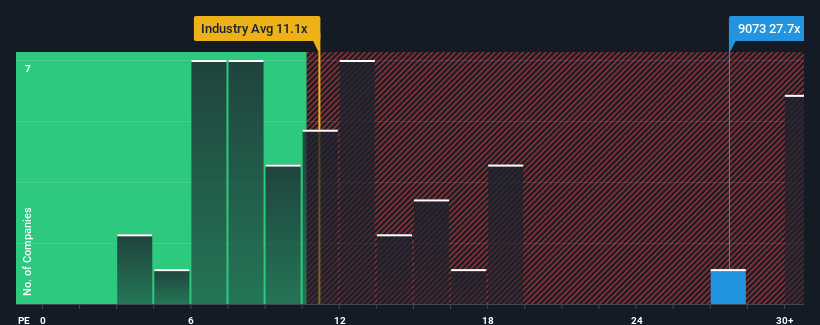- Japan
- /
- Transportation
- /
- TSE:9073
Kyogoku unyu shoji Co., Ltd.'s (TSE:9073) Share Price Not Quite Adding Up

When close to half the companies in Japan have price-to-earnings ratios (or "P/E's") below 13x, you may consider Kyogoku unyu shoji Co., Ltd. (TSE:9073) as a stock to avoid entirely with its 27.7x P/E ratio. However, the P/E might be quite high for a reason and it requires further investigation to determine if it's justified.
With earnings growth that's exceedingly strong of late, Kyogoku unyu shoji has been doing very well. The P/E is probably high because investors think this strong earnings growth will be enough to outperform the broader market in the near future. You'd really hope so, otherwise you're paying a pretty hefty price for no particular reason.
See our latest analysis for Kyogoku unyu shoji

Does Growth Match The High P/E?
In order to justify its P/E ratio, Kyogoku unyu shoji would need to produce outstanding growth well in excess of the market.
Taking a look back first, we see that the company grew earnings per share by an impressive 108% last year. Despite this strong recent growth, it's still struggling to catch up as its three-year EPS frustratingly shrank by 49% overall. Therefore, it's fair to say the earnings growth recently has been undesirable for the company.
In contrast to the company, the rest of the market is expected to grow by 12% over the next year, which really puts the company's recent medium-term earnings decline into perspective.
With this information, we find it concerning that Kyogoku unyu shoji is trading at a P/E higher than the market. Apparently many investors in the company are way more bullish than recent times would indicate and aren't willing to let go of their stock at any price. There's a very good chance existing shareholders are setting themselves up for future disappointment if the P/E falls to levels more in line with the recent negative growth rates.
The Key Takeaway
We'd say the price-to-earnings ratio's power isn't primarily as a valuation instrument but rather to gauge current investor sentiment and future expectations.
We've established that Kyogoku unyu shoji currently trades on a much higher than expected P/E since its recent earnings have been in decline over the medium-term. Right now we are increasingly uncomfortable with the high P/E as this earnings performance is highly unlikely to support such positive sentiment for long. Unless the recent medium-term conditions improve markedly, it's very challenging to accept these prices as being reasonable.
It is also worth noting that we have found 2 warning signs for Kyogoku unyu shoji (1 shouldn't be ignored!) that you need to take into consideration.
If these risks are making you reconsider your opinion on Kyogoku unyu shoji, explore our interactive list of high quality stocks to get an idea of what else is out there.
If you're looking to trade Kyogoku unyu shoji, open an account with the lowest-cost platform trusted by professionals, Interactive Brokers.
With clients in over 200 countries and territories, and access to 160 markets, IBKR lets you trade stocks, options, futures, forex, bonds and funds from a single integrated account.
Enjoy no hidden fees, no account minimums, and FX conversion rates as low as 0.03%, far better than what most brokers offer.
Sponsored ContentValuation is complex, but we're here to simplify it.
Discover if Kyogoku unyu shoji might be undervalued or overvalued with our detailed analysis, featuring fair value estimates, potential risks, dividends, insider trades, and its financial condition.
Access Free AnalysisHave feedback on this article? Concerned about the content? Get in touch with us directly. Alternatively, email editorial-team (at) simplywallst.com.
This article by Simply Wall St is general in nature. We provide commentary based on historical data and analyst forecasts only using an unbiased methodology and our articles are not intended to be financial advice. It does not constitute a recommendation to buy or sell any stock, and does not take account of your objectives, or your financial situation. We aim to bring you long-term focused analysis driven by fundamental data. Note that our analysis may not factor in the latest price-sensitive company announcements or qualitative material. Simply Wall St has no position in any stocks mentioned.
About TSE:9073
Flawless balance sheet with proven track record.


